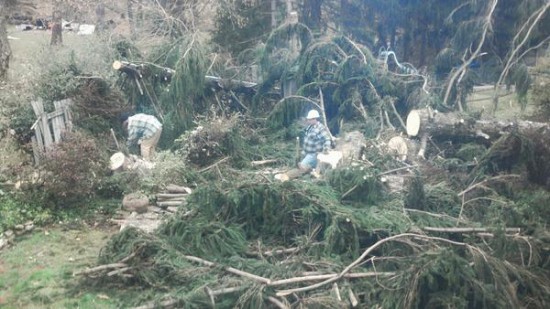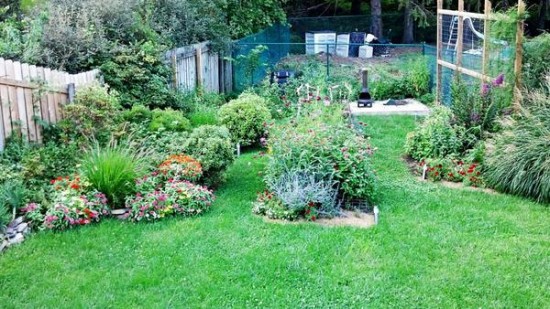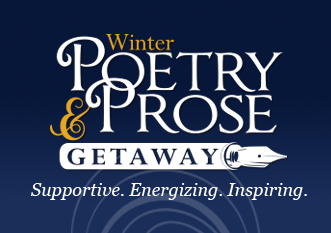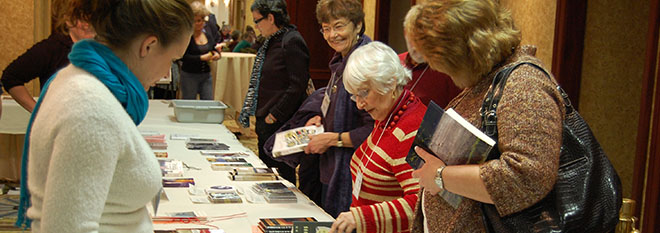Murphy Writing of Stockton College Presents

This entry is part of Getaway Reads, an e-mail series curated by Taylor Coyle that features the writing of the Winter Poetry & Prose Getaway faculty.
Learning my Place from Nature’s Graveyard
by Amanda Morris
Splintered fence. Shattered shrubs. Shredded trunks. And pine needles.
Everywhere, pine needles.
Destruction with the scent of Christmas.

As I made my way into the barely accessible remains of yard, gingerly pulling back heavy pine branches to expose anything left visible, I touched a ripped crape myrtle trunk and my eyes welled with tears. For the first time in my life, I felt a heart-level emotional connection to the land; my land.
The night before, Hurricane Sandy roared over South Mountain and howled through the Lehigh Valley at over 80 miles per hour, a sustained force that my neighbor’s 100-year-old pine trees could not withstand. During the night, over they fell, one atop the other in criss-cross pattern, burying my yard.
What I heard in the morning as I surveyed the space from the deck was the thick silence of death: Nature had transformed my personal landscape into a graveyard.
A transient woman by necessity and choice for over 25 years, I purchased this property in March 2012. After settling into a comfortable routine with my professorial career at a nearby university, I chose this place-based commitment as a sound financial investment but saw nothing more than a building and land that I was now responsible for maintaining. The lush lawn and well-established azalea, weigela, evergreen, japonica, and crape myrtle were planted by the previous owner. When I moved in, I weeded the mature beds, thinned the pachysandra and periwinkle, trimmed the shrubs, re-shaped the dogwood and cherry tree, and mowed the lawn.
My only foray into annual flowers were some magenta and red petunias in large pots and marigold seeds planted along the driveway fenceline. My practical approach yielded a pedestrian view that felt foreign to me, disconnected from my personality and creativity. The responsibility that I felt toward the building extended to the yard, which I thought should be maintained in its current state. After all, who rips out healthy, mature, established shrubs and groundcover to make way for a wilder, more vibrant, and less tame garden? In a weird way, I felt I would be disrespecting the former owner, an older gentleman who died in the midst of settlement, four days after signing our agreement of sale. His presence, his choices, his personality and preferences dominated my landscape. Until Sandy.
My education in rootedness was planted by the wind and the hurricane’s awful finality. Trees that had stood a century fell without fanfare. A yard that had been carefully planted and plucked into submission lay dying beneath a shroud of pine boughs and needles, the ground pierced by four-inch thick branches in dozens of places; so deep that they will never be removed. A weathered gray wood fence and beige Rubbermaid shed that had appeared sturdy and resilient crunched and crumbled into useless shards and remnants.
Never had I experienced such destruction, having only seen natural disasters from the comfort of my living room on television. On one hand, I was thankful that my home wasn’t destroyed, as so many were during that storm. On the other hand, my gratefulness did not soften the sadness reverberating within; I mourned the beautiful yard I had once possessed. Most of us understand on an intellectual level that all things in the natural world die and change, but suddenly this knowledge bombarded my heart center and I felt.
I felt angry. Of all the yards in my neighborhood, why ours? My neighbors on both sides suffered similar levels of devastation, albeit not as complete as mine.
I felt confused. Living 90 miles inland from the Atlantic Ocean on the side of a mountain should provide some protection, shouldn’t it?
I felt sad. All of those beautiful plants. So tall and lush and healthy. Crushed. As if they were never there.
Homeowners with more experience know how naive these thoughts are, but on that morning, I felt gut-punched. For the first time in my life, I felt despair.
Never one to wallow long, I set about the business of clearing the trees, hiring the necessary people for the work, arguing with my insurance company, and crying in frustration at regular intervals. The learning curve was steep and I did not go quietly or gently into the dawning knowledge that in death resides opportunity.
The day this idea sprouted was the day the tree removal service took away and ground up the last of the trees, leaving an ugly, barren, and shattered landscape.
As I looked over the scene from the deck, my imagination took over and helped my eyes to see differently. A vision emerged and I began to feel something new: excitement.
The graveyard transformed into a blank canvas upon which I could grow my own creative garden vision. I saw a tall green screen on the right side fenceline, high enough to block some of the view of my neighbor’s perpetually unused pool. A new sage green wooden shed with cream trim stood on the concrete pad. A long, bean-shaped planting bed traced itself in the center of my yard before my brightening eyes. I saw grass paths encircling this new center bed that was filled with blackberries, black-eyed susans, blanket flower, Russian sage, milkweed for monarch butterflies, and zinnias. Tall, wild, honey bee-covered zinnias in pink, red, orange, yellow, and white.
Suddenly, out of death, I saw life and an opportunity to learn about the land, the value of place, and myself. My first purchases were neon pink spray paint, landscape fabric, and 1200 pounds of soil, compost, and manure. Sadness dissipated into hours of physical labor as I created the first new bed under the dogwood in April 2013. Turning the thin grass over and covering it with new soil and compost was my therapy. With each 40 pound bag I hauled from the driveway, down six steps, and across the yard to rip open and dump onto this new bed full of promise, I healed.
Never had I worked so hard for so long with the land, but at the end of three days, my labor yielded a new garden bed encircled by a shallow rock wall, filled with transplanted hostas and bleeding hearts, newly purchased lobelia, petunias, begonias, golden corydalis, double fuschia, and Japanese hakone grass, plus some newly planted zinnia seeds.
Over the next four months, my sweetheart helped me to build the green screen which I planted with cypress vine and two varieties of clematis; I laid out, built, and planted the central bean-shaped bed; and I watched in utter delight as new growth shot up from the base of the crape myrtle and weigela.
By summer’s end my yard was alive again, but this time, with my imprint. My choices, my personality, my preferences now inform my outdoor space and I feel joy, calmness, and connection as I meander through the gardens now.

My experience with Sandy was fortuitous. Without that hurricane, I may not have learned the value of knowing my place. A wanderer no more, I have found my roots.
© Amanda Morris, 2014. Originally published in Garden Rant.
+ + + + + + + + + +
Amanda Morris, Ph.D., is a writer, scholar, adventurer and traveler who has lived in Pennsylvania and Alabama and is working on visiting all 50 states (she’s currently achieved 41). She teaches writing and rhetoric at Kutztown University of Pennsylvania, loves teaching students creative nonfiction and Indigenous Rhetorics, and recently spent three years as the University Writing Center Director. Her academic writing can be found in Rhetoric Review, Epiphany, WSQ, Journal of American Culture, South Atlantic Review and The Literary Encyclopedia. In her pre-academic life, Amanda spent a decade as a journalist with extensive and varied publication experience, and another decade as a media buyer for various advertising agencies. Amanda spends her free time cooking, fishing, gardening and dreaming up new writing projects to tackle. Fun fact: Amanda finished her doctorate in four years, defending her dissertation on her 40th birthday, thus proving that you are never too old to go back to school. Amanda’s professional home on the web has writing tips, writing prompts, and more information about her: amandamorrisphd.com.
+ + + + + + + + + +
Want to study with Amanda Morris? At the 2015 Winter Poetry & Prose Getaway, Amanda will lead What Matters is Not What Happened: Advanced Memoir.
+ + + + + + + + + +
Our Participants Say It Best
“As a first-time attendee, I was very impressed. The hotel was beautiful and everything was so well organized. My workshop leader, Amanda Morris, was full of energy, interesting, encouraging and inspiring. I would come back just for her, but I very much enjoyed the whole experience!”
~ Susan, Newtown, PA – More testimonials
Our Philosophy
Escape the distractions of your busy life. Advance your craft and energize your writing with a challenging and supportive Writing Getaway. Join us at one of our upcoming writing retreats and take advantage of plentiful writing time, insightful feedback, good meals and good company. Get Away to Write.
View our upcoming programs




